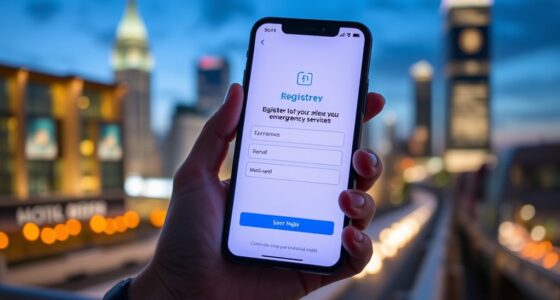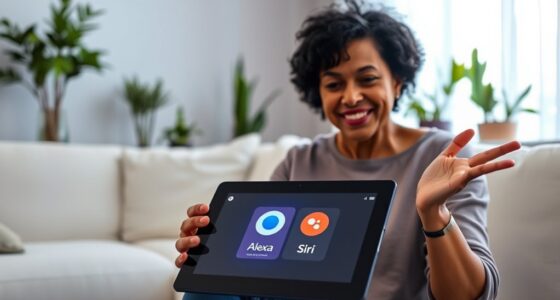To plan a wedding with deaf guests in mind, you should arrange for qualified sign language interpreters, position them where they can see all speakers clearly, and use visual tools like captioning devices and printed programs. Make sure your venue has good lighting, manageable acoustics, and a quiet environment to facilitate understanding. Coordinating these elements early helps create an inclusive atmosphere. Keep exploring to discover more ways to make the celebration accessible and enjoyable for everyone.
Key Takeaways
- Arrange for qualified sign language interpreters positioned visibly near the ceremony and reception areas.
- Incorporate captioning devices or real-time transcription services displayed on screens for clear understanding.
- Ensure venue lighting and acoustics support visual cues and minimize background noise for better communication.
- Provide detailed printed programs and visual aids to enhance accessibility and guest engagement.
- Brief staff and vendors on accessibility measures to ensure seamless support for deaf guests throughout the event.

Planning a wedding that includes deaf guests requires thoughtful preparation to guarantee everyone feels welcome and comfortable. One of the most effective ways to ensure clear communication is by providing sign language interpreters. These professionals translate spoken words into sign language, allowing deaf guests to follow the ceremony seamlessly. Arranging for qualified interpreters well in advance is vital, as it demonstrates your commitment to accessibility. Make sure they are positioned where they can easily see the officiant and speakers, ideally near the front of the venue. This positioning ensures that deaf guests don’t miss any important moments or heartfelt exchanges.
In addition to sign language interpreters, incorporating visual communication tools can greatly enhance the experience. Visual aids like captioning devices or real-time transcription services can be invaluable, especially during speeches or toasts. These tools display the dialogue on screens or devices, making it easy for deaf guests to stay engaged without missing key parts of the event. You might also consider providing printed programs with detailed descriptions of the ceremony, including any spoken elements, so guests can follow along at their own pace. Using multiple visual communication strategies shows your dedication to inclusivity and guarantees that every guest feels involved in the celebration.
Creating an accessible environment also involves considering the layout and acoustics of your venue. Ensure there’s good lighting so interpreters and captioning devices are visible, and avoid overly noisy spaces that could make hearing or understanding difficult. If your venue has background music during the ceremony, keep the volume at a level that allows guests to focus on the visual cues and spoken words. Additionally, brief your staff and vendors about the importance of accessibility measures, so they can assist guests if needed and help maintain an inclusive atmosphere.
Providing high-quality audio equipment can further support deaf and hard-of-hearing guests by amplifying sound and ensuring clarity throughout the event.
Frequently Asked Questions
How Can I Ensure Sign Language Interpreters Are Available Throughout the Event?
You should prioritize sign language certification and interpreter scheduling to guarantee effective communication. Contact professional interpreters early, confirming their certification and availability throughout your event. Provide clear instructions on the event schedule so they can prepare accordingly. Make arrangements for interpreters to be present at all key moments, like speeches and ceremonies. This proactive approach guarantees your deaf guests stay engaged and included, creating a welcoming atmosphere for everyone.
What Visual Communication Tools Work Best for Deaf Wedding Guests?
Visual tools truly transform communication, making moments more meaningful. You should consider sign language apps that facilitate quick, clear communication and visual alert systems that effectively notify guests of important announcements. These tools deliver direct, dynamic dialogue, ensuring deaf guests stay engaged and informed. By blending technology with traditional methods, you create a welcoming, inclusive environment where everyone feels comfortable celebrating together.
How Do I Inform Guests About Accessible Arrangements Beforehand?
You should guarantee your invitation clarity by explicitly mentioning accessible arrangements for deaf guests. Include RSVP details that ask guests to specify any special needs or accommodations. Send out the invitations well in advance, giving guests enough time to communicate their requirements. Consider adding a note about the available visual communication tools or interpreters, so everyone is aware of the accessible features and can prepare accordingly.
Are There Specific Accommodations for Deaf Guests During the Ceremony?
During the ceremony, you can provide assistive listening devices to help deaf guests hear clearly. Incorporate visual cues like sign language interpreters, captioning, or visual displays of key moments. These accommodations guarantee everyone stays engaged and understands the proceedings. Make sure to inform your guests in advance about these options so they know they’ll have the necessary support to fully enjoy your special day.
How Can I Create a Welcoming Environment for Deaf Attendees?
To create a welcoming environment for deaf attendees, you should incorporate gesture recognition and captioning technology throughout your event. Use sign language interpreters and guarantee real-time captioning is available for speeches and presentations. Make sure the venue is well-lit so visual cues are clear, and encourage staff to be attentive and accommodating. These steps make your guests feel included and comfortable, enhancing their overall experience.
Conclusion
By considering the needs of deaf guests, you’re creating an inclusive, memorable celebration for everyone. Remember, about 15% of adults in the U.S. experience some hearing loss, highlighting the importance of accessible communication. Incorporating sign language interpreters, visual cues, or captioning shows your thoughtfulness and respect. When you prioritize accessibility, your wedding becomes a beautiful event that truly celebrates love and unity for all guests, making it a day everyone will cherish.











